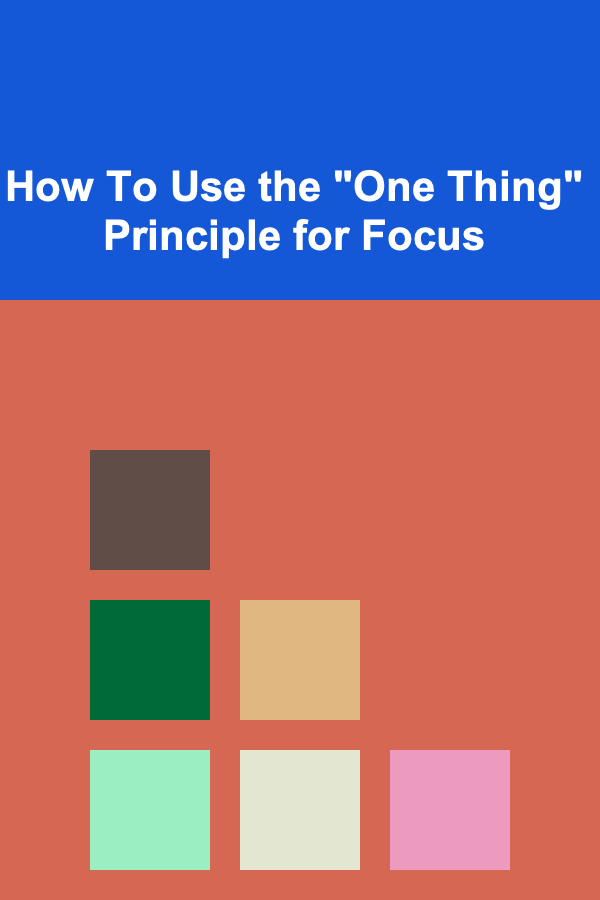
How To Use the "One Thing" Principle for Focus
ebook include PDF & Audio bundle (Micro Guide)
$12.99$7.99
Limited Time Offer! Order within the next:

In a world brimming with distractions, our ability to focus has become a rare and valuable skill. We are constantly pulled in different directions by emails, social media, meetings, and daily responsibilities. Yet, the secret to achieving success, whether in personal life, work, or creative pursuits, often lies not in multitasking but in single-tasking---focusing on "one thing" at a time. This is where the "One Thing" principle comes into play.
The "One Thing" principle is a concept that encourages individuals to focus on the most important task that will yield the most significant impact, rather than spreading their energy thin over multiple tasks. This principle, popularized by the book The One Thing by Gary Keller and Jay Papasan, offers a simple but profound way to increase productivity, enhance focus, and ultimately achieve greater success.
In this article, we'll delve into how to use the "One Thing" principle for focus, exploring its foundations, benefits, and practical strategies that you can apply in your own life.
The Foundations of the "One Thing" Principle
The central idea behind the "One Thing" principle is straightforward: rather than focusing on many tasks that might pull you in different directions, concentrate on the one task that will make the biggest impact. This task is often the one that, once completed, makes other tasks either easier or unnecessary.
Gary Keller and Jay Papasan introduce this concept in their book The One Thing: The Surprisingly Simple Truth Behind Extraordinary Results. They argue that focusing on just one thing enables you to get clear on what matters most and work toward it with intense focus, cutting out distractions along the way.
This principle challenges the widely accepted notion of multitasking, which research has shown can reduce productivity and increase cognitive load. Multitasking often leads to fragmented attention, where none of the tasks receive the level of focus they deserve. In contrast, focusing on the "one thing" allows you to direct your full attention toward a single goal, leading to better outcomes and a more efficient use of time.
Why Focus on the "One Thing"?
Before we dive into how to apply the "One Thing" principle in your life, let's take a moment to understand why focusing on one thing is so effective.
1. Eliminating Distractions
In today's world, distractions are abundant. We are constantly bombarded with notifications, meetings, and new tasks that need our attention. When we try to juggle many things at once, it becomes impossible to maintain deep focus. The "One Thing" principle eliminates this issue by forcing us to prioritize one task over everything else, allowing us to give it our full attention.
2. Increasing Productivity
Focus is a key factor in productivity. By narrowing your focus to the one task that matters most, you avoid wasting time on activities that don't contribute to your ultimate goal. In turn, this focused effort leads to faster completion and higher quality outcomes.
3. Better Results
When you focus on the one thing, you are less likely to scatter your energy across a wide array of tasks that might not move the needle significantly. By dedicating time and energy to what truly matters, you create the potential for extraordinary results, whether in your career, relationships, or personal goals.
4. Enhanced Clarity
The "One Thing" principle forces you to clarify your goals and identify what truly matters. When you're overwhelmed with tasks, it's easy to lose sight of the bigger picture. Focusing on one key objective brings clarity and purpose to your actions, helping you stay on track and motivated.
5. Improved Decision-Making
By identifying the one task that makes the greatest impact, you improve your ability to make better decisions. Instead of reacting to everything that comes your way, you become proactive about your goals, making more intentional and strategic choices.
The Practical Application of the "One Thing" Principle
While the idea of focusing on one thing sounds simple, applying it effectively requires discipline and a structured approach. Here are some practical strategies you can use to harness the power of the "One Thing" principle in your own life.
1. Identify Your One Thing
The first step in using the "One Thing" principle is to identify what your "one thing" is. This could be a long-term goal, a specific task, or an area of your life that requires the most attention. To do this, ask yourself a series of questions:
- What is the one thing that, if completed, will have the greatest impact on my life or career?
- What task will make everything else easier or unnecessary?
- What aligns with my highest values and long-term vision?
Your "one thing" may change over time depending on your goals, but it should always be something that will bring you closer to achieving your most important objectives.
For example:
- In your career, your "one thing" might be finishing a critical project that will open doors for advancement.
- In your personal life, it could be developing a new skill or cultivating a healthier lifestyle.
- In relationships, it might be spending quality time with family or friends to deepen your connections.
Be specific when identifying your "one thing." The clearer you are, the easier it will be to stay focused.
2. Set Clear, Achievable Goals
Once you've identified your "one thing," the next step is to break it down into clear, achievable goals. These smaller milestones act as stepping stones toward your larger objective. For instance, if your "one thing" is to write a book, your smaller goals might include:
- Writing 500 words a day
- Completing a chapter every week
- Editing and revising after finishing the draft
By setting clear, actionable goals, you create a roadmap that helps you stay focused on the "one thing" without feeling overwhelmed.
3. Create a Daily Routine
Consistency is key to making progress on your "one thing." Developing a daily routine that prioritizes your most important task ensures that you stay on track. Set aside dedicated time each day to work on your "one thing," ideally when your energy levels are highest.
For example, if you're most focused in the morning, schedule your most challenging tasks during that time. This will help you maximize productivity and avoid distractions that can pull you away from your main goal.
Additionally, make sure to incorporate breaks into your routine to avoid burnout. Consistent but manageable efforts will yield better results than trying to cram everything into a single day.
4. Eliminate Distractions
To stay focused on your "one thing," you must minimize distractions. This includes both external distractions (like social media and emails) and internal distractions (like wandering thoughts and self-doubt). Here are some strategies for reducing distractions:
- Turn off notifications on your phone or computer.
- Use apps or tools that block distracting websites during work hours.
- Set boundaries with coworkers, family, and friends so that you can focus on your task.
- Practice mindfulness techniques to calm your mind and stay focused.
Creating a distraction-free environment allows you to work with greater concentration and efficiency.
5. Review and Adjust Regularly
As you progress toward your goal, it's essential to review your progress regularly. Take the time to evaluate what's working, what's not, and make adjustments as needed. This will help you stay on course and prevent you from drifting off track.
At the end of each week, reflect on your achievements and challenges. Celebrate small victories and learn from setbacks. Adjust your strategy as necessary to stay aligned with your "one thing."
6. Say No to Other Tasks
To maintain focus on your "one thing," you must be willing to say no to other tasks and distractions that don't align with your primary objective. This requires a strong sense of discipline and prioritization.
Saying no doesn't mean you are being selfish or neglectful of other responsibilities. It simply means that you are choosing to focus on the most impactful task at the moment, which will ultimately serve your long-term goals better than spreading yourself thin.
7. Track Your Progress
Keeping track of your progress is an effective way to maintain momentum and stay focused on your goal. Use a journal, an app, or a simple checklist to mark off milestones and celebrate your progress. Seeing how far you've come can be a powerful motivator, especially when the journey feels long or challenging.
Tracking your progress also helps you stay accountable to your goal, ensuring that you don't lose sight of your "one thing."
The Impact of the "One Thing" Principle on Your Life
By focusing on the "one thing" that matters most, you create a clear path toward success and fulfillment. You reduce mental clutter, eliminate distractions, and align your actions with your highest priorities. This single-tasking approach allows you to:
- Achieve greater clarity and focus
- Enhance productivity and efficiency
- Make more intentional and strategic decisions
- Foster a deeper sense of purpose and fulfillment
Ultimately, the "One Thing" principle encourages you to simplify your approach to life and work, allowing you to achieve extraordinary results with less effort.
Conclusion
In a world of constant distractions, the "One Thing" principle offers a transformative approach to achieving success and maintaining focus. By identifying and dedicating yourself to the one task that will have the most significant impact, you streamline your efforts, reduce mental clutter, and set yourself up for extraordinary results. By applying this principle in your personal and professional life, you can unlock your full potential, create meaningful progress, and achieve your most important goals.

How to Handle Maintenance Requests and Repair Issues Efficiently
Read More
How to Store Seasonal Toys Effectively
Read More
How to Use Soundproofing Techniques for a Quieter Kitchen
Read More
How to Research Marine Ecotoxicology
Read More
How To Get Voluminous Hair with Simple Tricks
Read More
10 Tips for Printing Waterproof Labels at Home
Read MoreOther Products

How to Handle Maintenance Requests and Repair Issues Efficiently
Read More
How to Store Seasonal Toys Effectively
Read More
How to Use Soundproofing Techniques for a Quieter Kitchen
Read More
How to Research Marine Ecotoxicology
Read More
How To Get Voluminous Hair with Simple Tricks
Read More